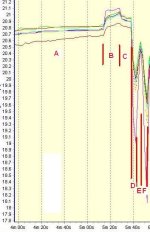Hiya all
Has anyone had any experience with running the new version 2.5 ping batteries with regenerative? Pings notes say to add a reverse current blocking diode in line with the power wires, and connect these wires together with the charging wires so any regen currents gets sent via the BMS. I would have thought there was no chance of overcharging the batteries or them needing balancing when doing regenerative braking. My ping is a 48 volt 15Ah and it states max charge current of 5A, but I see other 15Ah pings.. both 24 and 48 volt having 8A max.. and the lifetime specs say recharging current less than 1C (15A). Braking from 50kph (nine continents 2806 hub motor) would maybe throw out 10A, but only for a second or so.
I am loathe to add in a diode as the total power loss over time from this would be as much as regenerative adds (I have a long brakeless commute in the country, but some town stuff too where reducing the load on my brake pads would be beneficial)
anyone got any experience or views on this?
this is pings notes here with a picture. The regen notes are on page 6.
http://www.pingbattery.com/usrguide/Wiring%20Guide%20V2.5.pdf
cheeers! Greg
New Zealand
Ping 48v 15Ah, Nine Continents 2806 in 700c wheel. 25A controller.
Has anyone had any experience with running the new version 2.5 ping batteries with regenerative? Pings notes say to add a reverse current blocking diode in line with the power wires, and connect these wires together with the charging wires so any regen currents gets sent via the BMS. I would have thought there was no chance of overcharging the batteries or them needing balancing when doing regenerative braking. My ping is a 48 volt 15Ah and it states max charge current of 5A, but I see other 15Ah pings.. both 24 and 48 volt having 8A max.. and the lifetime specs say recharging current less than 1C (15A). Braking from 50kph (nine continents 2806 hub motor) would maybe throw out 10A, but only for a second or so.
I am loathe to add in a diode as the total power loss over time from this would be as much as regenerative adds (I have a long brakeless commute in the country, but some town stuff too where reducing the load on my brake pads would be beneficial)
anyone got any experience or views on this?
this is pings notes here with a picture. The regen notes are on page 6.
http://www.pingbattery.com/usrguide/Wiring%20Guide%20V2.5.pdf
cheeers! Greg
New Zealand
Ping 48v 15Ah, Nine Continents 2806 in 700c wheel. 25A controller.




